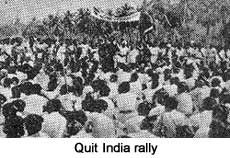

 |  |
 'Quit India,' 'Bharat Choro'. This simple but powerful slogan launched the legendary struggle which also became famous by the name of the 'August Revolution'. The failure of the Cripps Mission in April 1942 made it clear that Britain was unwilling to offer an honourable settlement and a real constitutional advance during the war.
Though Gandhiji himself had begun to talk of the coming struggle for sometime now, it was at the Working Committee meeting at Wardha on 14th July 1942 that the Congress first accepted the idea of a struggle. The All-India Congress Committee was then to meet in Bombay in August to ratify this decision.
'Quit India,' 'Bharat Choro'. This simple but powerful slogan launched the legendary struggle which also became famous by the name of the 'August Revolution'. The failure of the Cripps Mission in April 1942 made it clear that Britain was unwilling to offer an honourable settlement and a real constitutional advance during the war.
Though Gandhiji himself had begun to talk of the coming struggle for sometime now, it was at the Working Committee meeting at Wardha on 14th July 1942 that the Congress first accepted the idea of a struggle. The All-India Congress Committee was then to meet in Bombay in August to ratify this decision.The historic August meeting at Gowalia Tank in Bombay was unprecedented in the popular enthusiasm it generated. Huge crowds waited outside as the leaders deliberated on the issue. And the feeling of anticipation and expectation ran so high that in open session, when the leaders made their speeches before the many thousands who had collected to hear them, there was pin-drop silence. The Government, however, was in no mood to either negotiate with the Congress or wait for the movement to be formally launched, In the early hours of 9th August 1942, in a single sweep, all the top leaders of the Congress were arrested and taken to unknown destinations. Meanwhile, many provincial and local level leaders who had evaded arrest returned to their homes through devious routes and set about organizing resistance. As the news spread further in the rural areas, the villagers joined the townsmen in recording their protest. For the first six or seven weeks after 9 August, there was a tremendous mass upsurge all over the country. People devised a variety of ways of expressing their anger. In some places, huge crowds attacked police stations, post offices, kutcheries (courts), railway stations and other symbols of Government authority. National Flags were forcibly hoisted on public buildings in defiance of the police. At other places, groups of satyagrahis offered arrest in tehsil or district headquarters. Crowds of villagers, often numbering a few hundreds or even a couple of thousand, physically removed railway tracks. Elsewhere, small groups of individuals blew up bridges and removed tracks, and cut telephone and telegraph wires. Students went on strike in schools and colleges all over the country and busied themselves taking out processions, writing and distributing illegal news-sheets hundreds of these 'patrikas' came out all over the country. They also became couriers for the emerging underground networks. Workers too struck work. Particularly important centres of resistance in this phase were Azamgarh, Ballia and Gorakhpur in East U.P. and Gaya, Bhagalpur, Saran, Purnea, Shahabad, Muzaffarpur and Champaran in Bihar. continued.... next page >> |
Copyright ©2000 indiansaga.info. All rights reserved.
By using this service, you accept that you won't copy or use the data given in this website for any commercial purpose.
The material on indiansaga.info is for informational & educational purpose only.
This site is best viewed at 800 X 600 picture resolution.